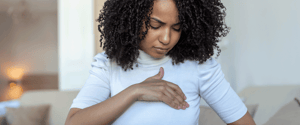
Recognising common cancers: How to check for breast cancer
It’s really important that you understand how to check your breasts for signs of cancer. This includes knowing what to look out for, how often to check, and when to seek help.
Breast cancer affects all genders, so it’s important for everyone to check regularly.
We know it can sometimes feel a little daunting, but in this Q&A we’ll talk you through everything you need to know.
What steps should you follow when checking your breasts?
• Look at both of your breasts in a mirror for any signs of change
• Use the flats of your fingers or palm of your hand to feel each breast
• Check your underarms and up to your collarbone, as you have breast tissue here too
Top tip: In the shower is a really good time to check, as you’ll be more relaxed.
How often should you check your breasts?
We’d advise you check your breasts once every month. You might want to set a reminder on your phone to make sure you don’t forget!
If you menstruate, does it matter what stage of your menstrual cycle you’re at?
Yes. If you have periods, you should wait until a few days after your period ends before checking your breasts, due to hormonal fluctuations.
What changes should you look out for?
Breast cancer doesn’t always present with a lump, so it’s important to look at your breasts for any changes. The main things to look out for when checking your breasts are:
• A change in the size of your breast/s or a significant change in shape of your breast/s
• A change in the look or feel of the skin on your breast, such as puckering, dimpling, a rash, or redness
• A new lump, swelling, or thickening in the breast/s or armpit that was not there before
• Abnormal discharge from the nipples
• A red/burnt type look on the breast/s
If you notice anything unusual, you should always get checked by your GP.
What changes are considered ‘normal’?
It’s normal for breasts to change through ageing, experiencing pregnancy, having children, or going through a menstrual period. Breasts can also feel swollen and tender when it’s time to ovulate.
However, you should always speak to your GP if you’re concerned about any changes.
How do you check painful/tender breasts when examination hurts?
Breasts can feel painful or tender when pregnant, ovulating, or during a menstruation period. Some people naturally have tender breasts some or all of the time. If you struggle to check your breasts, take some pain relief about half an hour before examination to help with the pain/tenderness. Pain relief gel applied to the breasts and surrounding areas can also help. If you wear a bra, it’s advisable to remove your bra for a short while before you self-examine, as this could be the cause of the discomfort.
When do you start having mammograms?
If there’s an abnormal change in your breast or a new lump, your GP will refer you to a breast clinic for further investigation.
Mammograms are routinely performed for women aged between 50-74. However, if there’s a history of breast cancer in the family, speak with your GP and request this be brought forward to ensure regular monitoring.
What support does Reframe offer around checking breasts and answering concerns?
Our nurses can talk you through how to check your breasts, and what to look out for. We’re also here to put your mind at rest about any concerns you may have. We can collate information around family and medical history, and talk you through genetic testing if you’re concerned about breast cancer with a hereditary link.
As experienced nurses, we can look at a picture of any changes on or around the breast/s if you want to send one in, but we’d usually encourage you to book a GP appointment. We can help you to prepare for this appointment, and support with next steps if your GP refers you to a breast clinic.
